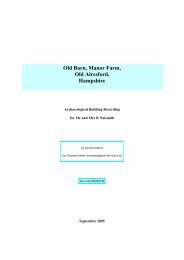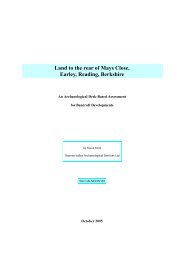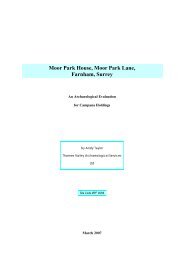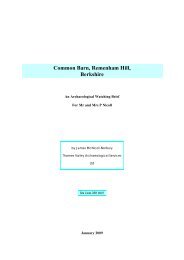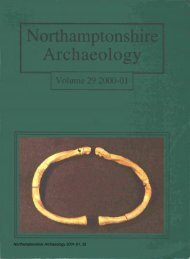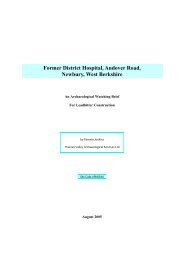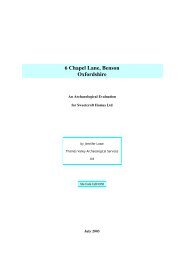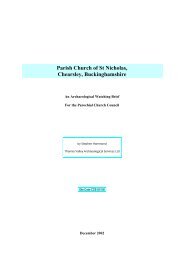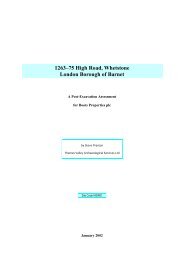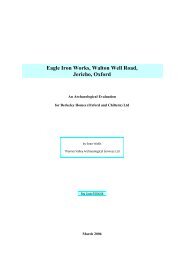Geophysical survey report - Thames Valley Archaeological Services
Geophysical survey report - Thames Valley Archaeological Services
Geophysical survey report - Thames Valley Archaeological Services
You also want an ePaper? Increase the reach of your titles
YUMPU automatically turns print PDFs into web optimized ePapers that Google loves.
group of strong localised bipolar and negative magnetic responses can be seen within the oval and suggest eitherbuilt-up or fired structures such as ovens, furnaces or hearths.Several other discreet positive anomalies are dotted around the field, not appearing to form part of anylarger groupings.Field E (Fig. 7)A linear positive anomaly can be seen clearly aligned northeast-southwest has potential to be of archaeologicalorigin [Fig. 7: E1]. However, excavations occurring on site during the <strong>survey</strong> to reroute a water pipe showed thatthis anomaly was in fact the water pipe that was being rerouted. A second strong positive linear anomaly isorientated parallel to the first in the southeast corner of the field [E2]. This one, however, is much wider and ismore likely to be archaeological in origin. Another strong positive anomaly can be seen in south-western cornerof the field [E3] and appears to be an extension of the probable geological feature also seen in Fields A and C[Fig. 6: A6, C3].Further positive anomalies but with weaker magnetic signatures can be seen to the south of the field alignedon east-west axis [E4] and to the north of the field aligned north-south [E5] and are possibly archaeological inorigin.A single strong localised magnetic response can be seen on the eastern boundary of the field, its appearancesuggesting magnetic disturbance caused by a near-by ferromagnetic object [E6]. A series of parallel lines similarto those found in Fields A, B and C also occur in Field E, again suggesting vehicle tracks [E7].Field FField F is characterised by two sets of linear positive anomalies which are broadly aligned north-south along thefield’s long axis. The first of these is a single strong anomaly accompanied by several sections of weaker parallellinear anomaly [F1] which can be interpreted as possible field boundaries or a trackway and are potentially ofarchaeological origin. To the east a second pair of stronger positive anomalies forms a more convincingtrackway leading northwards from the field’s south-eastern corner [F2]. Both of these sets of features are crossedby several fragmentary positive linear anomalies. In the west [F3], an apparent continuation of [E2], crosses [F1]and then possibly appears again in the north joining [F2]. A second linear anomaly [F4] leads from the westernboundary eastwards across the field, crossing [F1] but disappearing before it reaches [F2]. In the north a curvedanomaly [F5] appears to respect the line of [F2] but a second, slightly weaker anomaly [F6] cuts perpendicularlyacross it curving northwards into the magnetic disturbance caused by a modern pipe [F7].7



